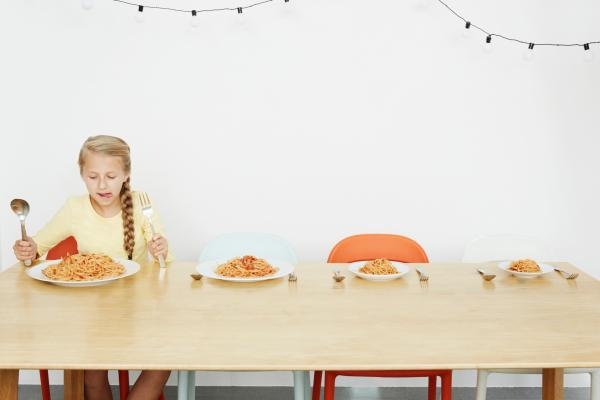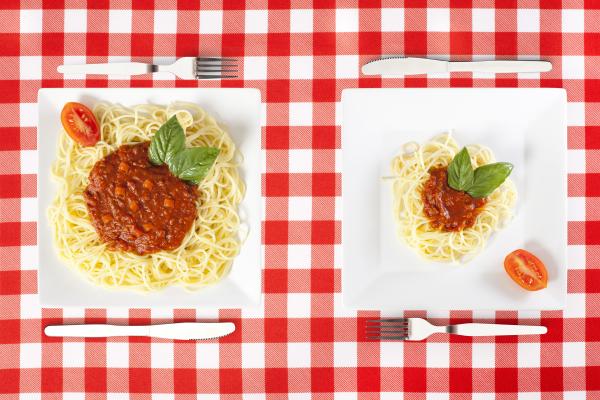Chapter 11. How Would You Know If Using Larger Dinner Plates Can Make Us Gain Weight?
11.1
By:
C. Nathan DeWall, University of Kentucky
David G. Myers, Hope College

Since this activity was created, some of the supporting research has been questioned. The general principles still hold true, but we will update this further in the next LaunchPad edition.
11.2
- Chapters
- descriptions off, selected
- captions settings, opens captions settings dialog
- captions off, selected
- English Captions
This is a modal window.
Beginning of dialog window. Escape will cancel and close the window.
End of dialog window.
This is a modal window. This modal can be closed by pressing the Escape key or activating the close button.
This is a modal window.
Note: You will be guided through the Intro, Design, Measure, Interpret, Conclusion, and Quiz sections of this activity. You can see your progress highlighted in the non-clickable, navigational list at the right.
Watch this video from your author, Nathan DeWall, for a helpful, very brief overview of the activity.
11.3

So, how would you know if using larger dinner plates can make us gain weight? To study this question effectively in your role as researcher, you need to DESIGN an appropriate study that will lead to meaningful results, MEASURE a behavior that is linked to weight gain, and INTERPRET the larger meaning of your results, considering how your findings would apply to the population as a whole.
We will start by choosing a good research DESIGN. From the options below, select the best one for finding out if using larger dinner plates can make us gain weight.
| A. |
| B. |
| C. |
Click on "Video Hint" below to see brief animations describing Case Studies, Correlational Studies, and Experiments.
Video Hint
11.4
Case Studies:
- Chapters
- descriptions off, selected
- captions settings, opens captions settings dialog
- captions off, selected
- English Captions
This is a modal window.
Beginning of dialog window. Escape will cancel and close the window.
End of dialog window.
This is a modal window. This modal can be closed by pressing the Escape key or activating the close button.
This is a modal window.
Correlational Studies:
- Chapters
- descriptions off, selected
- captions settings, opens captions settings dialog
- captions off, selected
- English Captions
This is a modal window.
Beginning of dialog window. Escape will cancel and close the window.
End of dialog window.
This is a modal window. This modal can be closed by pressing the Escape key or activating the close button.
This is a modal window.
Experiments:
- Chapters
- descriptions off, selected
- captions settings, opens captions settings dialog
- captions off, selected
- English Captions
This is a modal window.
Beginning of dialog window. Escape will cancel and close the window.
End of dialog window.
This is a modal window. This modal can be closed by pressing the Escape key or activating the close button.
This is a modal window.
11.5

You have chosen Case Study as your design. In a Case Study design, researchers choose one person or a small group of people and then study them in depth. For example, researchers may want to gain a deeper understanding of the lives of highly influential businesspeople. To accomplish their research goal, the researchers may spend months or years conducting interviews, personality assessments, and other research activities with a small group of well-regarded businesspeople.
Of the following options, which one represents the best participants for your Case Study?
| A. |
| B. |
| C. |
| D. |
11.6

What could we learn from these participant choices?
A small group of people who eat at restaurants every night. This option does not tell you about your participants’ weight or the size of the dinner plates they use. To know whether using larger dinner plates make us fat, you would need to study a group of individuals who have average body weight. This way you can determine whether changing the size of the plates they use causes them to behave in ways that will increase their weight.
A small group of people who are obese. This option tells you about your participants’ weight but not about the size of the dinner plates they use. To know whether using larger dinner plates makes us fat, you would need to study a group of individuals who have average body weight (not just people who are obese), and then vary the size of the dinner plates they use to see if that causes them to increase their weight.
A small group of people who are thin. This option tells you about your participants’ weight but not about the size of the dinner plates they use. To know whether using larger dinner plates makes us fat, you would need to study a group of individuals who have average body weight (not just people who are thin), and then vary the size of the dinner plates they use to see if that causes them to increase their weight.
A small group of people who have average body weight. You were right to choose people who have average body weight, but this option doesn’t tell us about the size of the dinner plates they use. To know whether using larger dinner plates makes us fat, you would need to study a group of individuals who have average body weight, and then vary the size of the dinner plates they use to see if that causes them to increase their weight. Also, you would need to study a large group, not a small group as in this Case Study approach, in order to determine whether the idea of using larger dinner plates making us fat may apply to the larger population.
Trying to choose a sample of participants helps us realize that a CASE STUDY IS NOT THE BEST RESEARCH DESIGN to test this question. To know whether using larger dinner plates can make us gain weight, we need to study a group of individuals who have average body weight, and then vary the size of the dinner plates they use to see if that causes them to gain weight. Also, we would need to study a large group, not a small group as in this Case Study approach, in order to determine if the idea of using larger dinner plates making us gain weight may apply to the larger population.
Click “Next” to go back and try again to select the most effective research design.
11.7

You have chosen a Correlational design, which means you want to study the association between two or more variables. For example, when testing whether feeling competent is related to working hard, a researcher could measure people’s feelings of competence and how many hours they spend working. This would allow researchers to determine whether feelings of competence relate to being motivated to work hard. (They do. Feeling competent relates to increased motivation.)
Describe below how you would set up your correlational study to determine whether using larger dinner plates can make us gain weight:
11.8

With a Correlational design, we might examine the association between the size of dinner plates people use and how much food they eat. As a result, we would learn something about the relationship between dinner plate size and eating behavior. But we would not know whether using larger dinner plates causes us to eat more or less food. Other factors affect eating behavior, such as whether the plate is a nice or ugly color, whether people are typically restrained or unrestrained eaters, and whether your participants have just completed a hard workout. To know whether using larger dinner plates causes us to gain weight, we need to systematically change the size of the dinner plates people use and measure their eating behavior, while controlling for the influences of other variables.
So, CORRELATIONAL IS NOT THE BEST RESEARCH DESIGN for this study. We’d get more helpful results by using a different design.
Click “Next” to go back and try again to select the most effective research design.
11.9

Nice work! You have correctly chosen to use an Experimental design for your study.
Next, you need to choose the most appropriate study participants.
Of the following choices, which one represents the best group of participants for your study?
| A. |
| B. |
| C. |
| D. |
11.10

You chose A group of people who eat at restaurants every night, but this is NOT CORRECT.
This choice doesn’t give you the information you need about participants’ weight. To know whether using larger dinner plates can make us gain weight, you would need to study a group of individuals who have average body weight. This way you can determine whether changing the size of the plates they use causes them to change their eating behaviors in ways that will increase their weight.
Click “Next” to try again to choose the most appropriate study participants.
11.11

You chose A group of people who are obese, but this is NOT CORRECT.
To study whether using larger dinner plates causes weight gain, it would be best to start with a group of individuals who have average body weight. This way you can determine whether varying the size of the plates they use causes them to change their eating behavior in ways that will increase their weight.
Click “Next” to try again to choose the most appropriate study participants.
11.12

You chose A group of people who are thin, but this is NOT CORRECT.
To study whether using larger dinner plates causes weight gain, it would be best to start with a group of individuals who have average body weight. This way you can determine whether varying the size of the plates they use causes them to change their eating behavior in ways that will increase their weight.
Click “Next” to try again to choose the most appropriate study participants.
11.13

Good job! You have correctly chosen to use an Experimental design, in which you will systematically change the size of dinner plates that people use. You also chose an appropriate sample of participants—a group of people who have average body weight. Now you need to determine how best to MEASURE the relevant behavior or mental process, which in this case is eating behavior.
11.14

Of the following options, which one represents the best way to measure whether using larger dinner plates can make us gain weight?
| A. |
| B. |
| C. |
| D. |
11.15
You chose Show people pictures of food, distract them for five minutes, and then test how well they remember the food pictures they saw, but this is NOT CORRECT.
This option would not give you information about participants’ eating behavior. It would only tell you how well they remembered food pictures. Remembering the food you see and eating the food you see are not the same thing. To know whether using larger dinner plates can make us gain weight, we have to measure actual eating behavior.
Click “Next” to try again to select the best way to measure whether using larger dinner plates can make us gain weight.
11.16
You chose Show people pictures of food and ask them how much they like each food they see, but this is NOT CORRECT.
This option would not help us, because it does not give us information about eating behavior. Knowing whether participants like certain foods might help us predict how they will eat. Or it might only tell us that people find certain foods more pleasing than other foods. To know whether using larger dinner plates can make us gain weight, we have to measure participants’ actual eating behavior.
Click “Next” to try again to select the best way to measure whether using larger dinner plates can make us gain weight.
11.17
You chose Measure how much food people say they would eat if they could serve themselves, but this is NOT CORRECT.
By choosing this option, you would be measuring intentions but not actual eating behavior. Our intentions are important, but they are not the same thing as our actual behavior. I might intend to eat vegetables but actually eat pizza. To know whether using larger dinner plates can make us gain weight, we have to measure participants’ actual eating behavior.
Click “Next” to try again to select the best way to measure whether using larger dinner plates can make us gain weight.
11.18

Good job! You have correctly chosen to use an Experimental design, in which you will systematically change the size of dinner plates that people use. You chose an appropriate sample of participants—a group of people who have average body weight. You also chose how best to MEASURE the relevant behavior or mental process, which in this case is eating behavior. You selected the option, Measure how much food people eat when they can serve themselves.
Actual research has in fact shown that using larger dishware causes people to eat more food (Wansink, 2006). For example, giving children a large, compared with a small, cereal bowl caused them to eat a lot more breakfast cereal (Wansink et al., 2014). Even if you give people yucky food (in one study, researchers used stale popcorn), they eat more if they eat out of a larger dish (Wansink & Kim, 2005). It is as if our brains shut off and we eat until our plates—no matter their size—are empty.
Knowing this, you need to consider how you can apply what you’ve learned to the larger population—beyond the people you’ve studied. Consider where you might encounter roadblocks to confidence in your results. What factors might keep you from being able to apply what you’ve learned in a broader context?
11.19

You tested whether using larger dinner plates can make us gain weight by measuring eating behavior when people serve themselves food on plates of varying sizes. As a scientist, you want to have confidence in your results. Several factors could affect eating behavior, and they might not have any relation to the size of plate that people use. Just think of the many reasons why you eat. Do you eat more food at certain times of the day? When you are cramming for an exam, do you reach for an extra helping of carrots, or candy? Factors that could interfere with your INTERPRETATION of results are called confounding variables.
From the list below, select all of the factors that could affect your confidence about whether using larger dinner plates causes weight gain:
| Whether participants own small, medium, or large dinner plates | |
| How much participants normally restrict their eating | |
| Whether the color of the various-sized plates differs | |
| Participants’ attitudes toward people who have dietary restrictions (e.g., food allergies, religious observances) | |
| Whether participants recently completed a difficult exercise activity |
Click on "Video Hint" below to see a brief animation describing Confounding Variables.
Video Hint
11.20
Confounding Variables:
- Chapters
- descriptions off, selected
- captions settings, opens captions settings dialog
- captions off, selected
- English Captions
This is a modal window.
Beginning of dialog window. Escape will cancel and close the window.
End of dialog window.
This is a modal window. This modal can be closed by pressing the Escape key or activating the close button.
This is a modal window.
11.21

The confounding variables for your study would include those highlighted below:
| Whether participants own small, medium, or large dinner plates | |
| How much participants normally restrict their eating | |
| Whether the color of the various-sized plates differs | |
| Participants’ attitudes toward people who have dietary restrictions (e.g., food allergies, religious observances) | |
| Whether participants recently completed a difficult exercise activity |
The highlighted confounding variables relate to your confidence in whether using larger dinner plates can make us gain weight.
Some people more than others will naturally restrict how much they eat, which will affect their consumption levels in the experiment independent of plate size. Controlling for this variable will help you determine how much of your observed effect is due to plate size.
You will also want to make sure all participants use the same color dinner plates. If the large plates are a pleasant color and the small plates are an unpleasant color, for example, eating behavior might change because of differences in plate color instead of differences in plate size.
You would also want to track whether your participants had recently completed a difficult exercise activity. Being drained of physical energy can influence eating behavior. By keeping track of participants’ recent exercise activity, you can have greater confidence that any changes in eating behavior are due to changing the size of plates they used.
Note that you are randomly assigning people to use either large or small dinner plates, which will help you control for natural intake restriction, exercise, and many other variables. With random assignment, each participant has the same chance of being assigned to each group. This should give each of your groups a balanced number of participants for whom natural restriction or recent exercise may be a factor.
Click on "Video Hint" below to see a brief animation describing Random Assignment.
Video Hint
11.22
Random Assignment:
- Chapters
- descriptions off, selected
- captions settings, opens captions settings dialog
- captions off, selected
- English Captions
This is a modal window.
Beginning of dialog window. Escape will cancel and close the window.
End of dialog window.
This is a modal window. This modal can be closed by pressing the Escape key or activating the close button.
This is a modal window.
11.23
- Chapters
- descriptions off, selected
- captions settings, opens captions settings dialog
- captions off, selected
- English Captions
This is a modal window.
Beginning of dialog window. Escape will cancel and close the window.
End of dialog window.
This is a modal window. This modal can be closed by pressing the Escape key or activating the close button.
This is a modal window.
You may do better on the Quiz if you take notes while watching this video. Feel free to pause the video or re-watch it as often as you like.
REFERENCES
Geier, A. B., Rozin, P., & Doros, G. (2006). Unit bias a new heuristic that helps explain the effect of portion size on food intake. Psychological Science, 17, 521-525.
Wansink, B. (2006). Mindless eating: Why we eat more than we think. New York: Bantam.
Wansink, B., & Kim, J. (2005). Bad popcorn in big buckets: Portion size can influence intake as much as taste. Journal of Nutrition Education and Behavior, 37, 242-245.
Wansink, B., & van Ittersum, K. (2013). Portion size me: plate-size induced consumption norms and win-win solutions for reducing food intake and waste. Journal of Experimental Psychology: Applied, 19, 320.
Wansink, B., van Ittersum, K., & Payne, C. R. (2014). Larger bowl size increases the amount of cereal children request, consume, and waste. Journal of Pediatrics, 164, 323-326.
11.24
QUIZ: NOW WHAT DO YOU KNOW?
1. According to the results of your experiment, people would eat ________ candy if they used a bowl that was ________ than the one they normally use.
| A. |
| B. |
| C. |
| D. |
2. Which of the following statements is TRUE, based on what you learned from this activity?
| A. |
| B. |
| C. |
| D. |
3. Why did you choose to use an Experimental design?
| A. |
| B. |
| C. |
| D. |
4. As one of your confounding variables, you chose whether participants had recently completed a difficult exercise activity. Why did you select this as a possible confounding variable?
| A. |
| B. |
| C. |
| D. |
5. If someone asks you whether using larger dinner plates can make us gain weight, how might you respond based on what you learned in this activity?